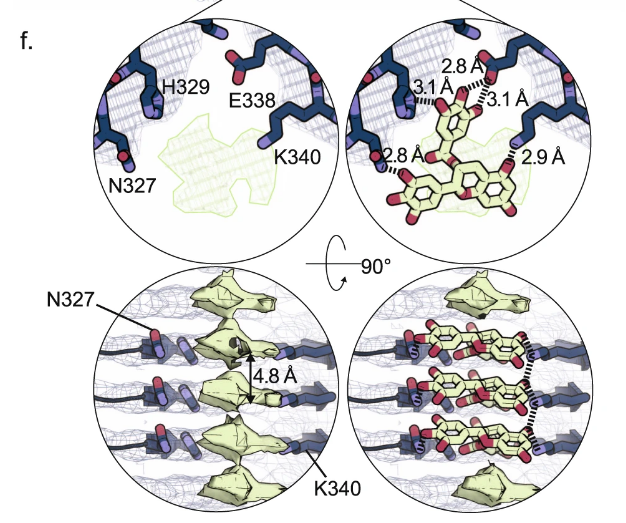
Very glad to have contributed to this paper, which David Eisenberg (citing Churchill) called "the end of the beginning" in the fight to cure Alzheimer's - just published in @NatureComms!
1/
nature.com/articles/s4146…
1/
nature.com/articles/s4146…
The paper started when @SeidlerPM decided to see just how the natural product EGCG, produced prominently in green tea, could be such a potent disaggregator of the usually hyper-stable Alzheimer's disease tau amyloid fibrils.
2/
2/
EGCG was interesting because it disaggregates a wide variety of amyloid fibrils with no external energy input - unlike chaperones which require ATP hydrolysis, for instance.
He thought if we could learn how it disaggregates amyloid fibrils, we could use that knowledge...
3/
He thought if we could learn how it disaggregates amyloid fibrils, we could use that knowledge...
3/
...to find other molecules that would be better drugs for AD (EGCG is not stable in the body and doesn't cross the blood-brain barrier).
So Paul cryogenically trapped AD tau fibrils while they were undergoing disaggregation by EGCG.
4/
So Paul cryogenically trapped AD tau fibrils while they were undergoing disaggregation by EGCG.
4/
And we used #cryoem to determine the structure of AD tau fibrils with and without EGCG, identifying three possible binding sites for EGCG, the strongest of which lies at the protofilament interface - which we termed the EGCG pharmacophore.
5/
5/

Using this pharmacophore, @Kevin_A_Murray computationally screened a library of FDA-approved small molecules, as well as the ChemBridge CNS-set (molecules predicted to penetrate the brain) and found additional binders to the EGCG pharmacophore that stop AD fibril seeding!
6/
6/

Upon further characterization, several of these compounds also disaggregate AD tau fibrils in vitro similar to, although not as well as, EGCG!
7/
7/

Using solvation energy calculations, we show that the EGCG-bound fibrils are substantially less stable than non-EGCG bound fibrils, which makes sense since EGCG is in the middle of breaking down the fibrils.
The major destabilization occurs in the EGCG binding pocket.
8/
The major destabilization occurs in the EGCG binding pocket.
8/

We hypothesized that EGCG could be disrupting the intricate network of charge-pairing that is occurring in fibrils, where stacks of "like" charges (e.g., Lys, Glu) are stabilized by having adjacent "charge pairs" and EGCG disrupts those charge pairs when it is bound.
9/

9/


But while disrupting charge-pairing may destabilize the fibrils, there is another reason why EGCG may dissolve these normally intractable fibrils!
This is where the brilliant Michael Sawaya came in with the "EGCG curvature" hypothesis.
10/
This is where the brilliant Michael Sawaya came in with the "EGCG curvature" hypothesis.
10/
Essentially, Michael observed that when EGCG is stacked along the fibrils, there is a void in between the EGCG molecules that is highly unfavorable. Molecules, especially carbon-based phenyl rings, do not like to have "gaps" where water can get in.
11/
11/
Indeed, in the crystal structure of EGCG, EGCG is stacked upon itself to occlude water. This is also similar to how in crystal structures of amyloid peptides, Phe and Tyr molecules "tilt" to make van der Waal's contacts with their neighbors in the fibril.
12/
12/
Michael hypothesized that EGCG may "bend" or "curve" to allow EGCG-EGCG interactions to occur, potentially leading to the fibril layers becoming pried apart. MD simulations by Kevin also showed this phenomenon.
13/

13/


Taken together, the disruption of charge pairing and EGCG curvature suggests a fibril disaggregation coordinate diagram that looks something like this:
(Importantly, we showed the disaggregated products are non-toxic and non-seeding competent!)
14/
(Importantly, we showed the disaggregated products are non-toxic and non-seeding competent!)
14/

So why might this paper represent the "end of the beginning" for Alzheimer's drug research? Because structure-based drug design is a major tool that has had success in many other diseases such as cancer and metabolic diseases, and we can start to use it for Alzheimer's too!
15/
15/
This work would not be possible without all the vast improvements in #cryoem that have occurred over the last few years, and the multi-year effort of all the co-authors on the project. Really glad for this paper to finally come out!
Fin/
Fin/
• • •
Missing some Tweet in this thread? You can try to
force a refresh




